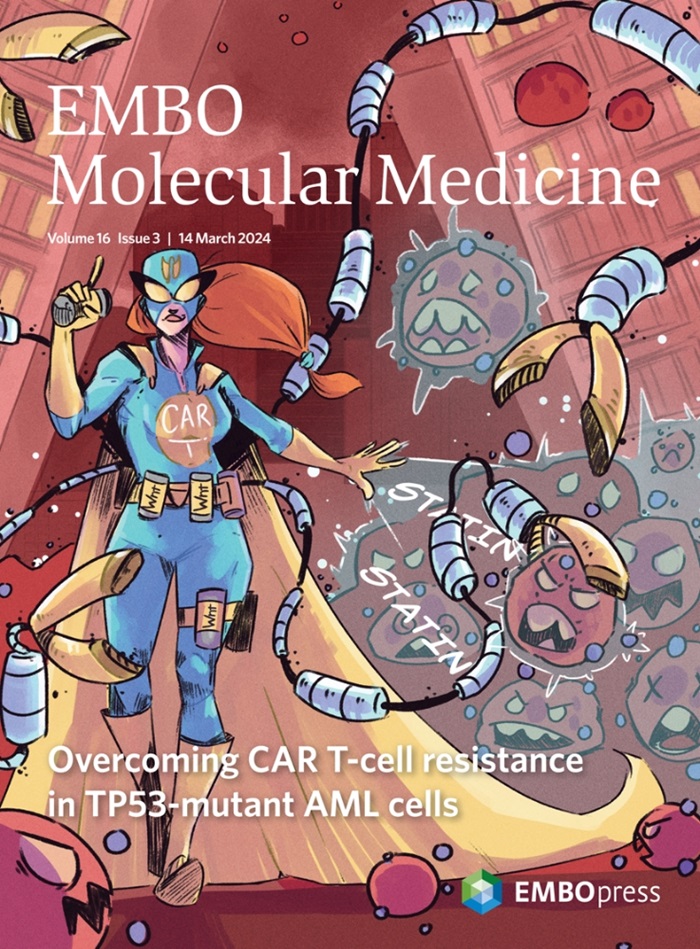SFX-01对Shp2激活突变引起的骨髓增生性疾病具有治疗作用。
IF 9
1区 医学
Q1 MEDICINE, RESEARCH & EXPERIMENTAL
引用次数: 0
摘要
Src同源-2结构域蛋白酪氨酸磷酸酶-2 (Shp2)的激活突变可导致多种儿童疾病,包括青少年髓细胞白血病(JMML)和努南综合征,这些疾病的治疗需求尚未得到满足。SFX-01是一种α-环糊精稳定的萝卜硫素复合物,目前正在临床开发中,共价加合半胱氨酸残基。利用无偏蛋白质组学,确定了其蛋白靶点,包括Shp2。SFX-01诱导了Shp2活性位点半胱氨酸的抑制性二硫代硫酮修饰。重要的是,在D61G Shp2过度活跃的人类努南综合征转基因小鼠模型中,SFX-01同时使其磷酸酶活性和髓细胞计数正常化。此外,SFX-01还能减弱与STAT1信号相关的JMML人患者来源的造血干细胞增殖,并降低cyclin D1表达,导致细胞周期阻滞。我们得出结论,SFX-01是一种激活突变Shp2抑制剂,可能对JMML或Noonan综合征患者有有益作用。本文章由计算机程序翻译,如有差异,请以英文原文为准。
SFX-01 is therapeutic against myeloproliferative disorders caused by activating mutations in Shp2.
Activating mutations of Src homology-2 domain-containing protein tyrosine phosphatase-2 (Shp2) cause multiple childhood conditions for which there is an unmet therapeutic need, including juvenile myelomonocytic leukemia (JMML) and Noonan syndrome. SFX-01, an α-cyclodextrin-stabilized sulforaphane complex currently in clinical development, covalently adducts cysteine residues. Using unbiased proteomics, its protein targets were identified, including Shp2. SFX-01 induced an inhibitory dithiolethione modification at the Shp2 active site cysteine. Importantly, in a transgenic mouse model of human Noonan syndrome with hyperactive D61G Shp2, SFX-01 concomitantly normalized their phosphatase activity and myeloid cell count. Furthermore, SFX-01 also attenuated JMML human patient-derived hematopoietic stem cell proliferation that was linked to STAT1 signaling and decreased cyclin D1 expression, resulting in cell-cycle arrest. We conclude that SFX-01 is an activating mutant Shp2 inhibitor and may offer beneficial effects in patients with JMML or Noonan syndrome.
求助全文
通过发布文献求助,成功后即可免费获取论文全文。
去求助
来源期刊

EMBO Molecular Medicine
医学-医学:研究与实验
CiteScore
17.70
自引率
0.90%
发文量
105
审稿时长
4-8 weeks
期刊介绍:
EMBO Molecular Medicine is an open access journal in the field of experimental medicine, dedicated to science at the interface between clinical research and basic life sciences. In addition to human data, we welcome original studies performed in cells and/or animals provided they demonstrate human disease relevance.
To enhance and better specify our commitment to precision medicine, we have expanded the scope of EMM and call for contributions in the following fields:
Environmental health and medicine, in particular studies in the field of environmental medicine in its functional and mechanistic aspects (exposome studies, toxicology, biomarkers, modeling, and intervention).
Clinical studies and case reports - Human clinical studies providing decisive clues how to control a given disease (epidemiological, pathophysiological, therapeutic, and vaccine studies). Case reports supporting hypothesis-driven research on the disease.
Biomedical technologies - Studies that present innovative materials, tools, devices, and technologies with direct translational potential and applicability (imaging technologies, drug delivery systems, tissue engineering, and AI)
 求助内容:
求助内容: 应助结果提醒方式:
应助结果提醒方式:


